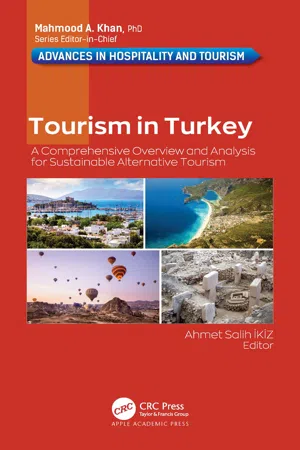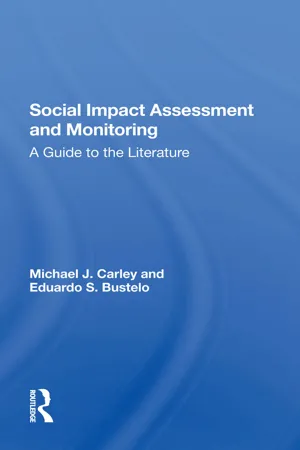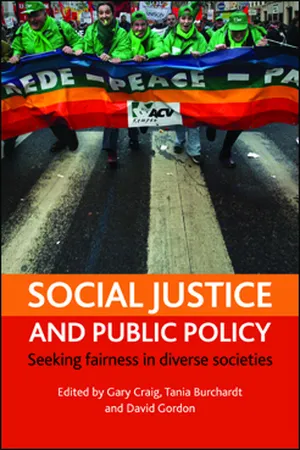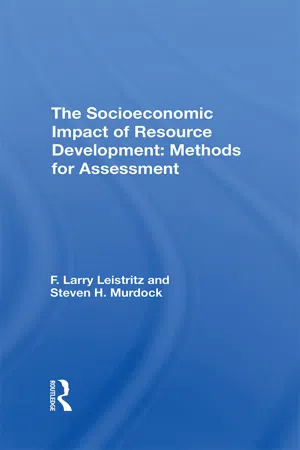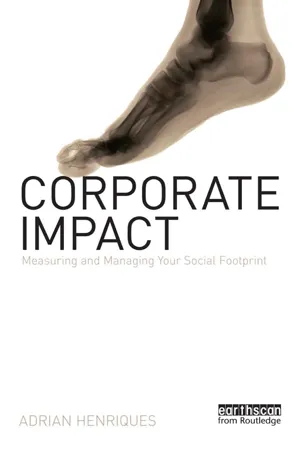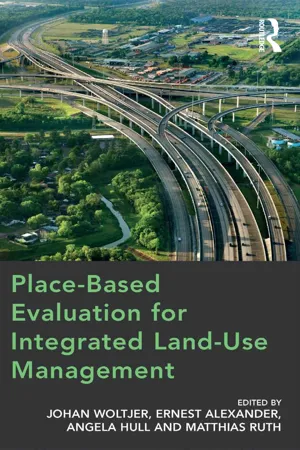Social Sciences
Environmental Impacts of Development
Environmental impacts of development refer to the effects that human activities, such as urbanization, industrialization, and infrastructure construction, have on the natural environment. These impacts can include habitat destruction, pollution, deforestation, and loss of biodiversity. Understanding and mitigating these impacts is crucial for sustainable development and the preservation of ecosystems and natural resources.
Written by Perlego with AI-assistance
Related key terms
Related key terms
1 of 4
Related key terms
1 of 3
6 Key excerpts on "Environmental Impacts of Development"
- eBook - ePub
Tourism in Turkey
A Comprehensive Overview and Analysis for Sustainable Alternative Tourism
- Ahmet Salih İkiz, Ahmet Salih İkiz(Authors)
- 2021(Publication Date)
- Apple Academic Press(Publisher)
Changes in consumption forms: The consumption forms are changing from the traditional, local forms to the national and international forms. An emergence of consumption forms that is popular in the global market.- Changes in production factors: Changing human resources using and demanding new technologies; educational, occupational, and linguistic changes.
- Cultural impacts: The cultural production and consumption forms of the society have been changed. The traditional life forms and customs have been changed to more modern forms.
- Changes in norms: Traditional social tests and preferences have been changed. The social behavior that was not accepted by society before the tourism development; however, it has been accepted after that.
- Consumption of the culture: Entertainment, religious rituals, marriage ceremonies, local arts, and literature that are framed by the traditional culture and custom have been changed to more national and international forms.
- Impacts on the natural environment: A degradation of the ecological, historical, and geographical resources, and fauna and flora. General pollution in the natural environment, particularly pollution on air, soil, and water).
The demographic, economic, and cultural impacts of tourism development are identified as social environment. Then, the impacts of tourism on the environment can be divided as two subjects: impacts of tourism on the natural environment and impacts of tourism on the social environment. Insofar, the social environment is just nested in the natural environment; in other words, the natural environment comprehends the social environment. Therefore, the policies to minimize the negative impacts of tourism development on the environment give a priority to a specific protection of the natural environment.9.8 THE ENVIRONMENTAL DIMENSION OF TOURISM
The environment might be defined as the natural and artificial factors that are determining human life. The environment has multidimensional factors. These factors are biological, physical, and sociocultural categories. Human beings have always tried to maximize usage of natural resources throughout history. Therefore, human societies created an artificial environment on the natural environment. If it has been looked at from a historical perspective; the usage and manipulation of the natural environment was very limited in the hunting and gathering societies and the agricultural societies. However, a maximum level has been reached in the modern industrial societies to maximize economic benefit and social welfare (Benton, 2001 - eBook - ePub
Social Impact Assessment And Monitoring
A Guide To The Literature
- Michael J Carley, Eduardo Bustelo(Authors)
- 2019(Publication Date)
- Routledge(Publisher)
Part 1 Focus on Social Impact AssessmentPassage contains an image
1 Social Impact Assessment: A Brief Description
Origins
During the past decade, and especially in the last few years, there has been a growing interest in attempts to gauge the socio-environmental effects of new resource and industrial developments. This interest originated in a reaction against an overdependence on economic criteria as a measure of the vague but real concept known as the quality of life. The most lasting and visible results of this reaction against what has been labelled "economic Philistinism" have been the environmental movement and the social indicators movement. Both are based on the assumption that an overly-economic perspective on technological change, development, and economic growth ignores important social and environmental factors and unintended consequences of action, all of which have marked effects on the quality of life.More specifically, interest in assessing socio-environmental factors associated with particular projects arose as a reaction against the deficiencies of traditional assessment techniques. These, it was felt, overemphasized economic criteria in judging project worthiness. For example, cost-benefit analysis seemed unable to deal with the question of the distribution of costs and benefits (or impacts) across various sectors of society, and with "intangible" or unquantifiable effects. And yet these factors could have obviously dramatic impacts on quality of life.This dissatisfaction with traditional methods of economic analysis was related to a number of trends which have been collectively associated with the environmental movement. One has been identified as a reaction against a limited economic perspective, which was reflected in an increasing concern over the depletion of non-renewable resources. This was embodied in the growth-no growth debate which was highlighted by the famous Club of Rome report The Limits to Growth, - eBook - ePub
Social justice and public policy
Seeking fairness in diverse societies
- Craig, Gary, Burchardt, Tania(Authors)
- 2008(Publication Date)
- Policy Press(Publisher)
Environmental justice: equality and equityFox (1989) argues, however, that environmental protection needs to understand the social forms of domination within society based on class, ‘race’ or gender. Social ecologists or eco-sociologists follow Fox’s proposition that social exclusion accounts for greater complexity than traditional ‘Greens’ allow and that the definition of their environment is hence too narrow. They suggest that any definition of the environment should include the concerns of people, such as the inequitable distribution of natural resources, environmental pollution, poverty or inner-city decay. Sustainable development, while recognising the intrinsic value of the environment, also supports a definition of environment broader than just fauna and flora, and is linked to poverty, environmental protection and human rights issues.The narrative of equality and justice within the context of environmental justice often refers to the equal or equitable share of the environment (built and natural) of all humans. It predominantly relates to the inequitable impact of environmental ‘bads’, such as pollution and dirty industries, on socially excluded communities. Environmental equality is thus closely related to discussions on ‘ecological debt’ or ‘ecological footprints’. Each is concerned with who benefits from and who pays the cost for the environment and its degradation (McClaren, 2003).These considerations are reflected in the sustainable development debate – sustainable development being development that gives equal consideration to social, economic and environmental concerns. Brundtland argues that sustainable development is based on the premise that environmental degradation is based on human activity, but more specifically the activities of the most affluent. Dealing with this inequitable impact is seen as crucial to increasing environmental standards, improving equitable shares of environmental resources, poverty alleviation and strengthening the democratic process.There are a number of perspectives on how environmental and sustainable development issues are defined within a social justice paradigm. However, the common theme of environmental justice is constructed around the political and legal concepts of substantive civil and political rights. The main components of environmental justice are based most of all on the right of all to a fair environment, a substantive right embedded in natural law, and the right of all human beings to equal resources. The civil and political process then defines the paradigm of empowering participation, access to information and resources (social and political), allowing all human beings to make informed decisions on the environment at micro and macro levels, both between and within generations. - eBook - ePub
The Socioeconomic Impact Of Resource Development
Methods For Assessment
- F. Larry Leistritz, Steve H. Murdock, F Larry Leistritz(Authors)
- 2019(Publication Date)
- Routledge(Publisher)
1 Introduction: Dimensions of Impact AssessmentAny attempt to assess the impacts of resource developments will involve an examination of an extremely broad range of theoretical and methodological considerations. It is necessary then to begin the discussion by specifying; (1) the rationale behind the focus of the work; (2) the specific focus and limitations placed on the effort; (3) the range of conditions and factors likely to significantly affect key impact categories; and (4) the basic organization of the text.Rationale for an Assessment of Socioeconomic Impact Assessment Techniques
Recent trends toward industrial decentralization have led an increasing number of firms to locate new facilities in rural areas (Summers et al ., 1976). Similarly, changes in the nation's energy supply patterns point toward the increasing development of large-scale energy resource extraction and conversion projects in sparsely populated rural areas, particularly in the western United States. These developments present both benefits and problems to the communities nearby. While new industrial and resource development projects offer the benefits of new jobs and provide a stimulus to the local economy, they also pose the problem of rapid population growth -- a problem which few rural communities are prepared to handle.The socioeconomic changes occurring during the construction and subsequent operation of large energy conversion plants exemplify the paradoxical effects of many types of industrial facilities on rural areas. Such projects often lead to long desired increases in local employment and to general economic growth in the area. However, the total magnitude of economic growth associated with such projects, the rapidity of the fluctuations of such patterns during the lifetime of the project, the public service demands created by growth, and the uncertainty of the timing and specific location of many of the impacts create severe planning problems for local areas. - eBook - ePub
Corporate Impact
Measuring and Managing Your Social Footprint
- Adrian Henriques(Author)
- 2010(Publication Date)
- Routledge(Publisher)
7 Sociological ImpactsThis chapter describes two techniques which borrow much from sociology: social impact analysis and social capital. To varying degrees they both look at society as the primary context or object of analysis, rather than the company or its stakeholders. Nevertheless, they are both important representations of sociologically informed techniques useful to understanding some aspects of corporate impact.SOCIAL IMPACT ASSESSMENTHistoryThe idea of systematically assessing the full range of consequences of actual and potential policy has a long heritage in public policy and decision making. The phrase ‘Social Impact Assessment (SIA)’ was born in the late 1960s and 1970s. It emerged as a result of concern over the impact of large public sector projects such as oil pipeline construction. The idea of using social science as a tool to assess the impact of such projects was enshrined in the US National Environmental Policy Act of 1969, which in section 102 requires all agencies of the Federal Government to ‘utilize a systematic, interdisciplinary approach which will insure the integrated use of the natural and social sciences and the environmental design arts in planning and in decision making which may have an impact on man’s environment’ (USA, 1969). Also, from as early as 1980 the United Nations Environment Programme (UNEP) has in practice been assessing the social as well as environmental consequences of development projects. Today in the UK, for example, through the New Approach to Transport (NATA) Guidelines, as well as in the USA, a relatively integrated assessment of the environmental and social impacts of major projects is normal. In addition, drafts of UK Bills are required to be accompanied by suitable impact assessments, which typically include economic, environmental and social issues in some form.Another driver of social impact assessment has been the foreign aid and development policies of many governments. Overseas development was originally primarily economic in intent. However, the somewhat over-simplified early prescriptions for economic development met with very limited success. As a result, the social consequences of such interventions became ever more central to international development efforts. Today most international development agencies, including international organizations such as the World Bank, routinely require project assessments. It is therefore commonplace for social impact assessments to be made of international development initiatives – giving rise, as we have seen, to the idea of sustainable development. - Johan Woltjer, Ernest Alexander, Matthias Ruth(Authors)
- 2016(Publication Date)
- Routledge(Publisher)
PART II: Understanding the Evaluation of Impacts and SpacePassage contains an image
Chapter 6 Current Trends in Social Impact Assessment: Implications for Infrastructure Developments
Ana Maria Esteves and Frank VanclayDOI: 10.4324/9781315600604-8Introduction
Social impact assessment (SIA) developed alongside environmental impact assessment (EIA) in the early 1970s as an ex-ante mechanism to consider the social impacts of planned interventions (Burdge and Vanclay, 1995 ; Vanclay , 2014). Early understandings of SIA were narrowly conceptualised, tending to apply SIA only at the project level, only considering a narrow selection of first-order impacts, with the role of SIA being limited to the predictive assessment of the negative consequences of projects in the context of a regulatory framework triggered only by a change in the biophysical environment (Vanclay, 2006 ). This limited understanding of SIA pervaded and continues to dominate the legislation, policy, procedures and organizational cultures of the environmental management agencies of many countries as well as many environmental consultancies. In contrast, nowadays most SIA professionals consider that SIA is more than a technique or step, it is philosophy about development and democracy. As such, ideally it considers the pathologies of development (i.e. impacts), the goals of development (such as poverty alleviation), and the processes of development (e.g. participation, capacity building) (Vanclay, 2003 , 2004 ). Thus, SIA should also be involved in assisting communities to determine their development priorities, as well as a process for incorporating social dimensions into projects (Esteves and Vanclay, 2009 ; Esteves et al., 2012 ).The contemporary understanding is that SIA is about ‘the processes of managing the social issues associated with planned interventions’ (Esteves et al., 2012
Index pages curate the most relevant extracts from our library of academic textbooks. They’ve been created using an in-house natural language model (NLM), each adding context and meaning to key research topics.
Explore more topic indexes
Explore more topic indexes
1 of 6
Explore more topic indexes
1 of 4
